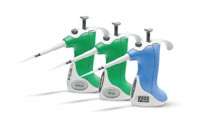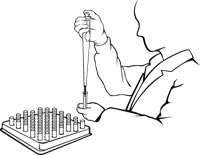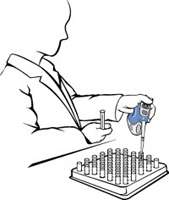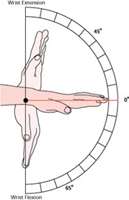Articles
Carpal Tunnel Syndrome: A Rising Statistic Among Laboratory Workers
Tue, 04/08/2024 - 9:54am
LISTED UNDER:
by Richard Minnihan
Introduction
Ergonomic injuries are widely recognized as a major factor in work place health. About one-third of all occupational injuries and illnesses stem from over exertion and/or repetitive motion. The cost to industry in workers' compensation costs range from $15-20 billion annually, and total costs are estimated in excess of $50 billion.
According to the U.S. Department of Labor Occupational Safety & Health Administration (OSHA), of all work-related repetitive injuries, Carpal Tunnel Syndrome (CTS) results in more days on average away from work than any other workplace injury. The median number of days away from work for CTS is 25 days, compared to 17 days for fractures, and 20 days for amputations. Workers with severe injuries can face permanent disability, which will prevent them from returning to their job or handling simple everyday tasks. The act of picking up a child, or even pushing a shopping cart, can become a painful experience.
CTS: A rising statistic in the laboratory
A common cause of CTS is inflammation of the tendons in the carpal tunnel, which can be attributed to repetitive use of the hand and/or wrist in positions that may create increased fluid pressure in the carpal tunnel. Studies have shown that an increase of fluid pressure in the carpal tunnel of 40-50 mmHg sustained for 60 minutes can result in transient changes in nerve function, while as little as 30 mmHg of fluid pressure over 4 hours can cause prolonged effects on tissue.¹ Laboratory workers who use pipettes experience a higher risk of this injury. Repetitive twisting of the forearm between the palm up and palm down positions (supination and pronation of the forearm) throughout the pipetting task, as well as wrist flexion and extension increases the fluid pressure. As the study referenced in this document indicates, tissues within the carpal tunnel are subjected to increasing fluid pressure as the forearm is rotated from a neutral position of 45-degree pronation (palm down) to full supination.¹ This rotation of the forearm, commonly associated with pipetting, can potentially increase fluid pressure in the carpal tunnel by as much as 285%.
Recent testing revealed that the new Ovation® BioNatural™ Pipette showed significant reduction in forearm rotation and wrist flexion during use when compared to traditional, axial designed pipettes. Ovation encourages the user's hand, wrist and arm to assume the neutral postures near 45-degree pronation recommended by ergonomic experts. As shown in figure 1, forearm rotation during aspirating and dispensing was 25-degree pronation, compared to 65-degree supination observed with traditional pipettes. Figure 2 shows that Ovation also allowed wrist extension and flexion to remain within recommended limits, further encouraging proper posture while pipetting.
Although a critical pressure-time threshold associated with CTS has yet to be determined, in order to reduce the risk of this injury, individuals should use pipettes designed for operation in neutral positions that cause the least amount of pressure on the carpal tunnel.
 |
Ergonomic injuries are widely recognized as a major factor in work place health. About one-third of all occupational injuries and illnesses stem from over exertion and/or repetitive motion. The cost to industry in workers' compensation costs range from $15-20 billion annually, and total costs are estimated in excess of $50 billion.
According to the U.S. Department of Labor Occupational Safety & Health Administration (OSHA), of all work-related repetitive injuries, Carpal Tunnel Syndrome (CTS) results in more days on average away from work than any other workplace injury. The median number of days away from work for CTS is 25 days, compared to 17 days for fractures, and 20 days for amputations. Workers with severe injuries can face permanent disability, which will prevent them from returning to their job or handling simple everyday tasks. The act of picking up a child, or even pushing a shopping cart, can become a painful experience.
CTS: A rising statistic in the laboratory
A common cause of CTS is inflammation of the tendons in the carpal tunnel, which can be attributed to repetitive use of the hand and/or wrist in positions that may create increased fluid pressure in the carpal tunnel. Studies have shown that an increase of fluid pressure in the carpal tunnel of 40-50 mmHg sustained for 60 minutes can result in transient changes in nerve function, while as little as 30 mmHg of fluid pressure over 4 hours can cause prolonged effects on tissue.¹ Laboratory workers who use pipettes experience a higher risk of this injury. Repetitive twisting of the forearm between the palm up and palm down positions (supination and pronation of the forearm) throughout the pipetting task, as well as wrist flexion and extension increases the fluid pressure. As the study referenced in this document indicates, tissues within the carpal tunnel are subjected to increasing fluid pressure as the forearm is rotated from a neutral position of 45-degree pronation (palm down) to full supination.¹ This rotation of the forearm, commonly associated with pipetting, can potentially increase fluid pressure in the carpal tunnel by as much as 285%.
 |  |  |
Although a critical pressure-time threshold associated with CTS has yet to be determined, in order to reduce the risk of this injury, individuals should use pipettes designed for operation in neutral positions that cause the least amount of pressure on the carpal tunnel.
 |  |  |
 Full forearm pronation.  Full forearm supination. |  | |
| Diagram of degrees of wrist extension/flexion, pronation/supination. | ||




